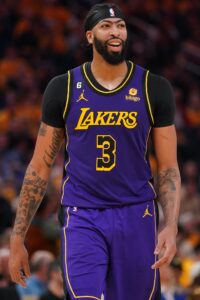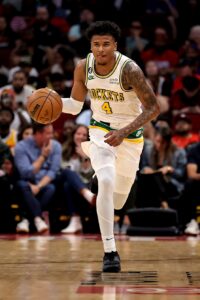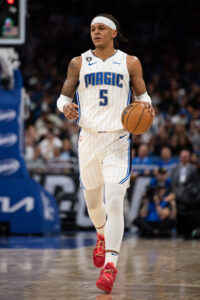An NBA team that want to re-sign a player before he reaches free agency can do so, but only at certain times and if his contract meets specific criteria.
Rookie scale extensions, which can be completed for former first-round picks between the third and fourth years of their rookie scale contracts, were the NBA’s most common form of extension in the past. But the league relaxed its criteria for veteran extensions in its 2017 Collective Bargaining Agreement and loosened them further in the 2023 CBA, resulting in a significant increase in those deals in recent years. They’ve now overtaken rookie scale extensions as the league’s most frequently signed extensions.
[RELATED: 2023/24 NBA Contract Extension Tracker]
A veteran extension is any contract extension that tacks additional years onto a contract that wasn’t a rookie scale deal. Even if the player is still on his first NBA contract, he can technically receive a “veteran” extension if he was initially signed as a second-round pick or an undrafted free agent rather than via the league’s rookie scale for first-rounders.
Here’s a full breakdown of how players become eligible to sign veteran extensions, and the limits that come along with them:
When can a player sign a veteran contract extension?
A team that wants to sign a player to a veteran extension wouldn’t be able to simply complete that extension one year after the initial contract was signed. The team must wait a specified period of time before the player becomes extension-eligible, as follows:
- If the player initially signed a three- or four-year contract: Second anniversary of signing date.
- Note: The second anniversary date also applies if the player previously signed an extension that lengthened his contract to three or four total seasons.
- If the player initially signed a five- or six-year contract: Third anniversary of signing date.
- Note: The third anniversary date also applies if the player previously signed an extension that lengthened his contract to five or six total seasons.
- If the player previously renegotiated his contract and increased his salary by more than 10%: Third anniversary of renegotiation date.
A contract that only covers one or two seasons is ineligible to be extended.
 The anniversary dates for signings have been complicated in recent years by the COVID-19 pandemic that forced the NBA to adjust its usual calendar during the 2019/20, ’20/21 and ’21/22 league years. For instance, the 2020 free agency period was delayed until November 21 instead of beginning on July 1.
The anniversary dates for signings have been complicated in recent years by the COVID-19 pandemic that forced the NBA to adjust its usual calendar during the 2019/20, ’20/21 and ’21/22 league years. For instance, the 2020 free agency period was delayed until November 21 instead of beginning on July 1.
Anthony Davis signed a five-year free agent contract on December 3, 2020, which would normally make him ineligible to be extended until December 3, 2023. However, the NBA adjusted that three-year waiting period to better reflect certain stages of the offseason rather than adhering to specific dates on the calendar. As a result, Davis was able to sign a new extension with the Lakers this year on August 4.
Going forward, the usual two- and three-year waiting periods will once again apply. For instance, after signing a three-year extension that lengthened his contract to five total seasons, Davis will become extension-eligible again on August 4, 2026.
It’s worth noting that an extension signed between October 2 and the start of the regular season is considered – for the purpose of determining its anniversary – to have been signed on October 1.
How many years can a player receive on a veteran extension?
A veteran extension can be for up to five years, including the year(s) remaining on the previous contract. The current league year always counts as one of those five years, even if an extension is agreed to as late as June 30.
For instance, when Bogdan Bogdanovic signed an extension in March with the Hawks, he was in the final year of previous contract, which ran through 2022/23. He added four extra years via the extension, maxing out at five years overall.
If a player signs a “designated” veteran extension, he can receive up to six total years, as we cover in a separate glossary entry. Devin Booker, Karl-Anthony Towns, and Nikola Jokic all took this route during the 2022 offseason after meeting the super-max criteria; Jaylen Brown has been the lone super-max recipient in the 2023 offseason.
How much money can a player receive on a veteran extension?
The first-year salary in a veteran extension can be worth up to 140% of the salary in the final year of the player’s previous contract or 140% of the NBA’s estimated average salary, whichever is greater. Annual raises are limited to 8% of the first-year extension salary.
When Dejounte Murray signed an extension with the Hawks this offseason, he added four extra years to the one year and $17,714,000 (base salary) remaining on his previous deal. Because that $17.7MM cap hit greatly exceeds the league’s estimated average salary, Murray was eligible to earn up to 140% of his final-year salary in the first year of his extension. As such, his new contract begins next season with a base salary of $24,799,600, with 8% annual raises from there.
In 2023/24, the NBA’s estimated average salary is $11,958,000, so a player earning less than that amount would be eligible to receive an extension worth up to 140% of that figure. That would work out to a starting salary of $16,741,200 and a four-year total of about $75MM.
A contract extension can’t exceed the maximum salary that a player is eligible to earn, so there are some instances in which a player won’t be able to get a full 40% raise on a new extension.
For instance, Davis’ new three-year extension should technically award him up to a 40% raise on his $43,219,440 salary in 2024/25. However, that would work out to a $60,507,216 salary in 2025/26 — even if the salary cap increases by the maximum allowable 10% in each of the next two summers, Davis’ maximum salary in ’25/26 would be $57,604,894 (35% of the cap). So he won’t receive a full 40% raise on his new deal.
Because a player’s own personal maximum salary on an extension is always at least 5% of his salary in the previous season, there are scenarios in which a player could exceed the league-wide maximum salary. But given the rate at which the cap has increased in recent years, there aren’t any practical examples of that at this point.
Designated veteran extensions and renegotiated contracts have slightly different rules for salaries and raises than standard veteran extensions. You can read about those differences in our glossary entries on those subjects.
Can a player sign a veteran extension as part of a trade?
The NBA’s Collective Bargaining Agreement does allow for extend-and-trade transactions, but the rules governing them are more limiting than for standard veteran extensions.
A player eligible for an extension can sign one in conjunction with a trade, but he would be limited to three overall years and a starting salary worth 105% of the final-year salary on his previous deal. Subsequent annual raises are limited to 5% as well.
A player who receives an extension that exceeds those extend-and-trade limits becomes ineligible to be traded for six months. Conversely, a player who is involved in a trade becomes ineligible to sign an extension for six months if the extension would exceed the extend-and-trade limits.
 Kristaps Porzingis‘s two-year extension with the Celtics is an example of a recent extension that didn’t exceed the extend-and-trade limits — he took a pay cut from $36,016,200 to $29,268,293 and the deal lengthened his contract to three total years. Because that extension fell within the extend-and-trade parameters, Porzingis was permitted to sign it less than a month after being traded.
Kristaps Porzingis‘s two-year extension with the Celtics is an example of a recent extension that didn’t exceed the extend-and-trade limits — he took a pay cut from $36,016,200 to $29,268,293 and the deal lengthened his contract to three total years. Because that extension fell within the extend-and-trade parameters, Porzingis was permitted to sign it less than a month after being traded.
Conversely, since Davis’ new extension lengthens his total contract to five years and will feature raises exceeding 5%, he’ll be ineligible to be traded until February 4, six months after he signed the deal.
These extend-and-trade restrictions will be modified beginning at the start of the 2024/25 league year. At that time, the extend-and-trade limits will increase from three total years and a starting salary up to 105% of the player’s previous salary to four total years and a starting salary up to 120% of the player’s previous salary (or 120% of the estimated average salary, for players earning below the average). The maximum 5% annual raise will remain in place.
Players who renegotiate their current-year salary as part of an extension can’t be traded for six months. This applies to players like Domantas Sabonis and Jordan Clarkson this summer.
An extension-eligible player can’t be extended-and-traded between the end of the season and June 30 if there’s a chance he could become a free agent that July. That rule applies to both veterans on expiring contracts and veterans with team or player options that have yet to be exercised.
For instance, prior to being traded to Boston, Porzingis wouldn’t have been eligible to sign an extension with the Wizards until he had exercised his player option for 2023/24.
What are the other rules related to veteran extensions?
There are many more minor rules and guidelines related to veteran extensions, including several involving bonuses and option years. A full breakdown can be found in Larry Coon’s CBA FAQ, but here are some of the notable ones most likely to come into play:
- A contract with an option can be extended if the player opts in or the team picks up the option.
- A contract with an option can also be extended if the option is declined, as long as the extension adds at least two new years to the deal and the first-year salary isn’t worth less than the option would have been. The only exception to this rule involves an early termination option — a contract with an ETO can’t be extended if the ETO is exercised, ending the contract early. This is why Davis waived his ETO when he signed his extension with the Lakers earlier this month.
- A newly signed extension can contain a player or team option, but not an early termination option.
- If a contract contains incentive bonuses, a veteran extension must contain the same bonuses. The bonus amounts can be increased or decreased by up to 8%, but they must still be part of the deal. An extension also can’t contain bonuses that weren’t part of the original contract.
- If a contract includes an unearned trade bonus, it doesn’t necessarily have to be applied to the extension. If the team and player elect not to carry over the trade bonus to the extension and the player is dealt before the extension takes effect, the application of the bonus would ignore the extension.
Note: This is a Hoops Rumors Glossary entry. Our glossary posts will explain specific rules relating to trades, free agency, or other aspects of the NBA’s Collective Bargaining Agreement. Larry Coon’s CBA FAQ was used in the creation of this post.
Previous versions of this post were published in 2019 and 2022.


